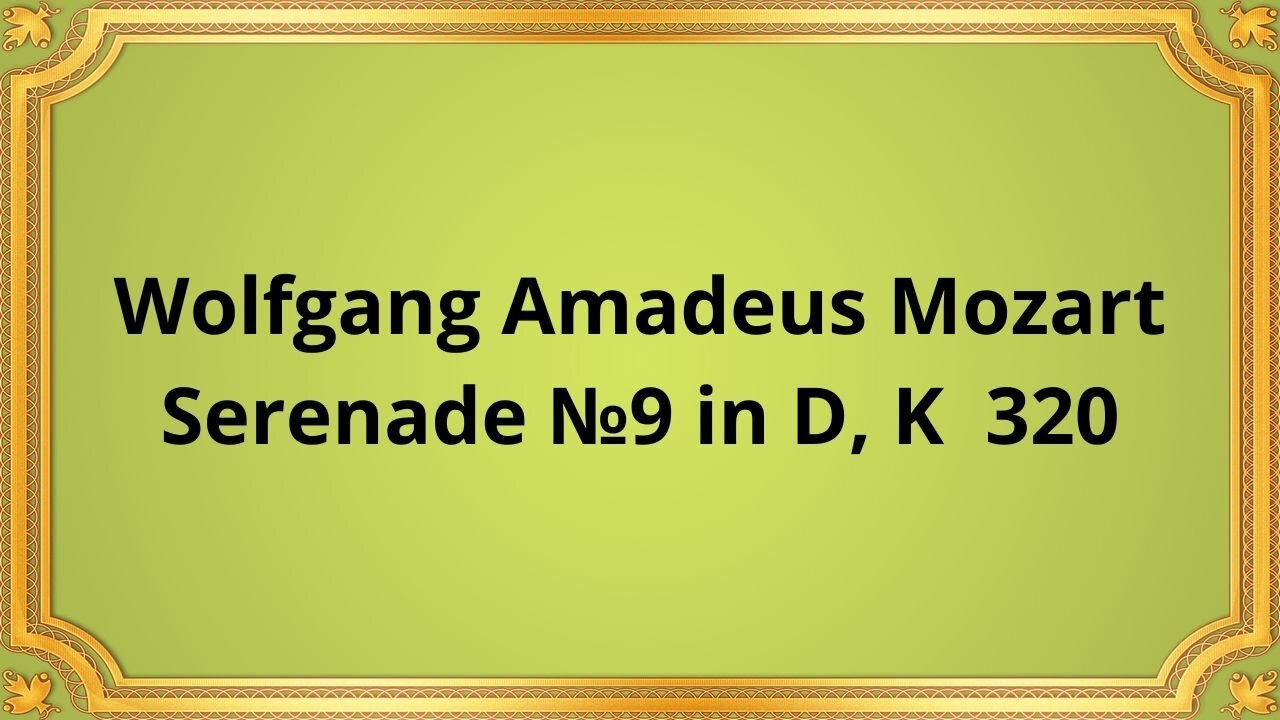Premium Only Content

Wolfgang Amadeus Mozart Serenade №9 in D, K 320, Posthorn Concertante and Rondo
#Mozart#Chamber_music#Classical_music#Serenade#Musical_composition
Wolfgang Amadeus Mozart Serenade №9 in D, K 320, Posthorn Concertante and Rondo
Publication date 1946
Vox Chamber Orchestra conducted by Edvard Fendler
Mozart Serenade No. 9 in D, K 320, also known as Posthorn Serenade, is one of the most famous serenades in music history. It was composed by Wolfgang Amadeus Mozart in 1779, when he was just 23 years old. The Serenade is scored for thirteen instruments, including a posthorn, which is a brass instrument similar to a trumpet.
The serenade is structured in thirteen movements, with a duration of approximately one hour. The first movement, marked "Adagio maestoso - Allegro con spirito", begins with a slow and majestic introduction, followed by an energetic and cheerful main theme. The second movement, marked "Menuetto", is a dance-like movement in triple meter, while the third movement, marked "Concertante", is a solo showcase for the featured instruments.
The fourth movement, marked "Andante grazioso", is a lyrical movement in which the posthorn plays an important role, displaying its sweet and warm timbre. The fifth movement is a playful and lively Scherzo, followed by a sentimental and emotional Romanze.
The seventh movement, marked "Menuetto - Trio I - Trio II", is a return of the second movement with two additional trios. The eighth movement, marked "Rondo - Allegro", is a virtuosic showcase for the featured instruments, particularly the posthorn.
The ninth movement, marked "Menuetto - Trio I - Trio II", returns to the dancelike character of the earlier menuettos. The tenth movement, marked "Adagio - Allegro molto", is a powerful and energetic movement with a triumphant main theme.
The eleventh movement is a beautiful and delicate Andante, while the twelfth movement, marked "Menuetto - Trio", features a playful and syncopated rhythm. The thirteenth and final movement, marked "Finale - Presto", is a joyful and lively conclusion to the serenade.
Mozart's Posthorn Serenade is a masterpiece of classical music, showcasing his remarkable talent and creativity. The use of the posthorn in several movements of the serenade adds a unique and charming quality to the piece, and the variety of moods and styles throughout the thirteen movements keeps the listener engaged and captivated.
-
 41:38
41:38
Classical music_Music Inspiration
1 month agoNikolai Andreevich Rimsky Korsakov Symphonic Suite “Scheherazade”
1721 -
 2:03:42
2:03:42
Inverted World Live
6 hours agoBigfoot Corpse Coming to the NY State Fair | Ep. 94
79.6K14 -
 LIVE
LIVE
SpartakusLIVE
7 hours ago$1,000 Pistol Challenge || #1 ENTERTAINER of The EONS Eradicates BOREDOM
996 watching -
 2:33:37
2:33:37
TimcastIRL
4 hours agoTrump Orders Review of Smithsonian For Being Woke & Out of Control | Timcast IRL
150K47 -
 3:09:10
3:09:10
Barry Cunningham
8 hours agoPRESIDENT TRUMP HAS TAKEN THE MONSTER AWAY FROM THE LEFT! HORROR STORIES WON'T WORK ANYMORE!
64K62 -
 1:29:55
1:29:55
WickedVirtue
2 hours agoLate Night Fortnite w/ Friends
13.3K -
 LIVE
LIVE
This is the Ray Gaming
3 hours ago $0.22 earnedCould you be? Would you be? Won't you be my RAYBOR? | Rumble Premium Creator
51 watching -
 1:46:52
1:46:52
JahBlessGames
4 hours ago🎉Come een' and come tru' - VIBES | MUSIC | GAMES
31.1K -
 38:47
38:47
MattMorseTV
5 hours ago $11.59 earned🔴Tulsi just CLEANED HOUSE.🔴
53.3K83 -
 6:24:06
6:24:06
Reolock
6 hours agoWoW Classic Hardcore | WE'RE BACK!!
20.9K2